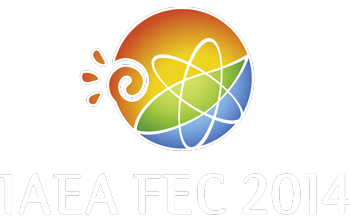Speaker
Dr
Amanda Hubbard
(Massachusetts Institute of Technology, Plasma Science and Fusion Center)
Description
I-Mode is a promising ELM-suppressed regime that combines H-mode-like energy confinement with L-mode-like particle and impurity transport. Key to its potential extrapolation to ITER and reactor regimes is the scaling of accessibility conditions and performance. The multi-machine experiments reported here, supported by the Pedestal and Edge Physics as well as Transport and Confinement ITPA groups, are the start of such studies. The regime has been most extensively studied on Alcator C-Mod but has also been explored for several years on ASDEX Upgrade. More recently, I-mode has been observed on DIII-D. Experiments on EAST and KSTAR are planned in 2014. Observations on the different devices share some general characteristics, but also reveal some differences.
In all devices, the I-mode is generally obtained under conditions for which the H-mode power threshold is high (e.g. unfavorable Bxgrad B drift). ICRH, NBI and ECH have each been used successfully. The key defining feature of the regime is the appearance of an edge temperature pedestal, similar to that in H-mode, while the edge density profile remains unchanged from L-mode. Particle and thermal transport are thus decoupled. The increase in Tped is accompanied by improvement in energy confinement. In the best cases, confinement exceeds H98y2, and can be maintained in stationary conditions for the duration of heating. The height of the temperature pedestal which can be obtained without transition to H-mode varies; in some conditions and devices confinement improvement is more modest. Understanding the conditions both for L-I and I-H mode transitions is thus critical.
Fluctuations in the pedestal region, and in the core plasma, also change at the transition to I-mode. Here there are some differences in observations on different devices. We will present the observed features of I-modes on each device. Pedestal profiles and parameters will be compared both in absolute parameters, which now span a very wide range, and in dimensionless parameters. Dimensionless identity experiments have been carried out between C-Mod and ASDEX Upgrade. Pedestal stability analysis has been conducted which explains the observed lack of ELMs. The transition power thresholds and normalized confinement properties will also be compared, and implications of these multi-device studies for extrapolation to ITER and DEMO discussed.
| Country or International Organisation | USA |
|---|---|
| Paper Number | EX/P6-22 |
Primary author
Dr
Amanda Hubbard
(Massachusetts Institute of Technology, Plasma Science and Fusion Center)
Co-authors
Dr
Alberto Loarte
(ITER Organization)
Dr
Alessandro Marinoni
(MIT Plasma Science and Fusion Center)
Prof.
Anne White
(MIT Plasma Science and Fusion Center)
Dr
Christian Theiler
(MIT Plasma Science and Fusion Center)
Prof.
Dennis Whyte
(MIT Plasma Science Fusion Center)
Dr
Earl Marmar
(MIT Plasma Science and Fusion Center)
Dr
Eleonora Viezzer
(Max-Planck-Institut fuer Plasmaphysik, Garching, Germany)
Dr
Elisabeth Wolfrum
(Max Planck Institut fuer Plasmaphysik)
Dr
Francois Ryter
(IPP-Garching)
Dr
George R. McKee
(University of Wisconsin-Madison)
Dr
Istvan Cziegler
(Univ. California San Diego)
Jerry Hughes
(MIT PSFC)
Dr
Jinseok Ko
(National Fusion Research Organization, Korea)
Dr
John Rice
(MIT PSFC)
Mr
John Walk
(MIT Plasma Science and Fusion Center)
Mr
L. Schmitz
(University of California-Los Angeles)
Dr
Laura Barrera Orte
(Max-Planck-Institut fuer Plasmaphysik, Garching, Germany)
Dr
Max Fenstermacher
(General Atomics)
Dr
Peter Manz
(Max-Planck-Institut fuer Plasmaphysik, Garching, Germany)
Dr
Punit Gohil
(General Atomics)
Mr
R. Michael Churchill
(MIT Plasma Science and Fusion Center)
Dr
Rachael McDermott
(Max Planck Institut für Plasmaphysik)
Dr
Rainer Fischer
(Max-Planck-Institut fuer Plasmaphysik, Garching, Germany)
Dr
Rajesh Maingi
(Princeton Plasma Physics Laboratory)
Dr
Stefan Gerhardt
(Princeton Plasma Physics Laboratory)
Dr
Stephen Wolfe
(MIT Plasma Science and Fusion Center)
Dr
T Zhang
(ASIPP, Hefei, China)
Dr
Thomas Osborne
(General Atomics)
Dr
Tim Happel
(Max-Planck-Institut fuer Plasmaphysik, Garching, Germany)
Prof.
Xiang Gao
(Institute of Plasma Physics, Chinese Academy of Sciences)
Ms
Zheng Yan
(University of Wisconsin-Madison)
Mr
Zixi Liu
(Institute of Plasma Physics, Chinese Academy of Sciences)

